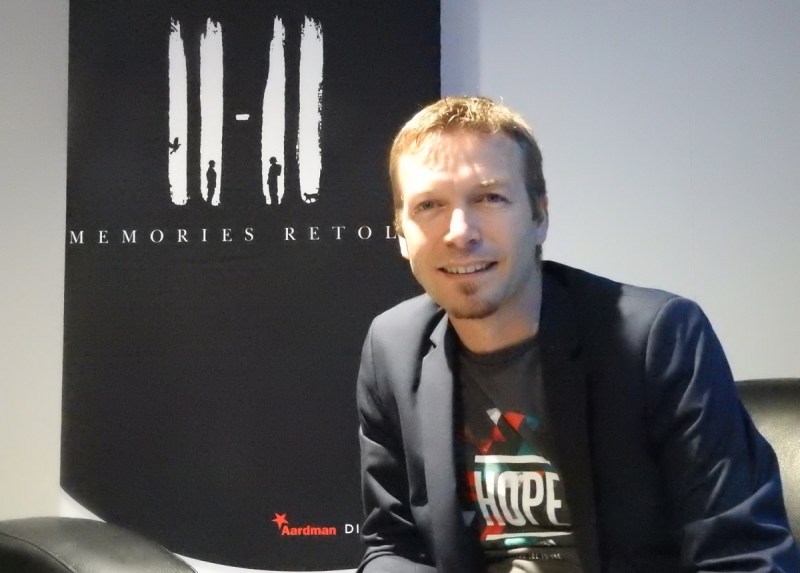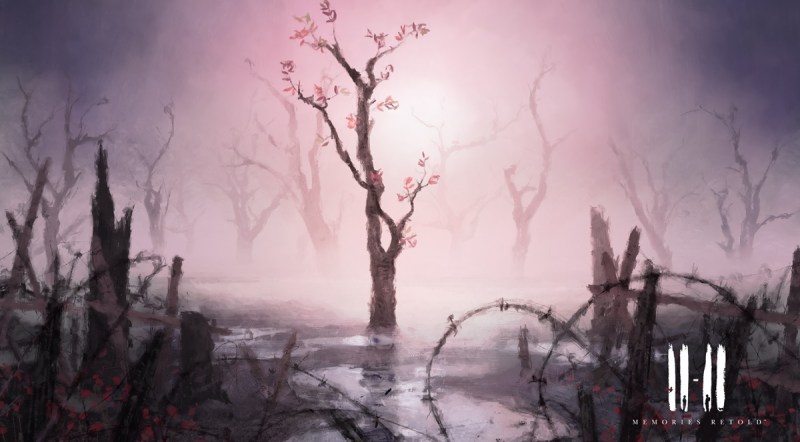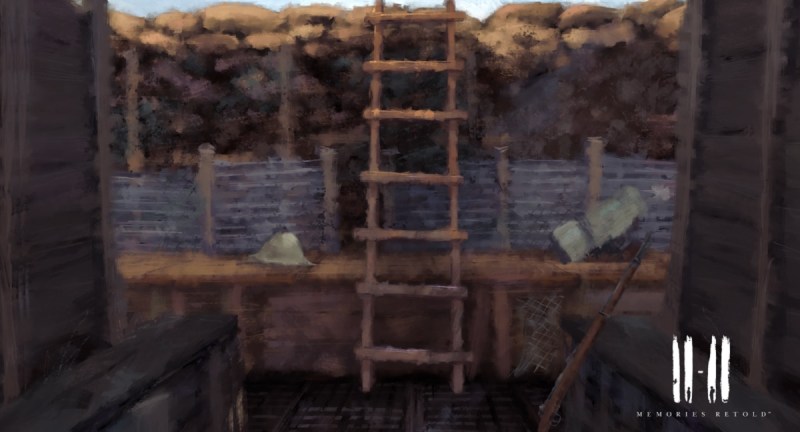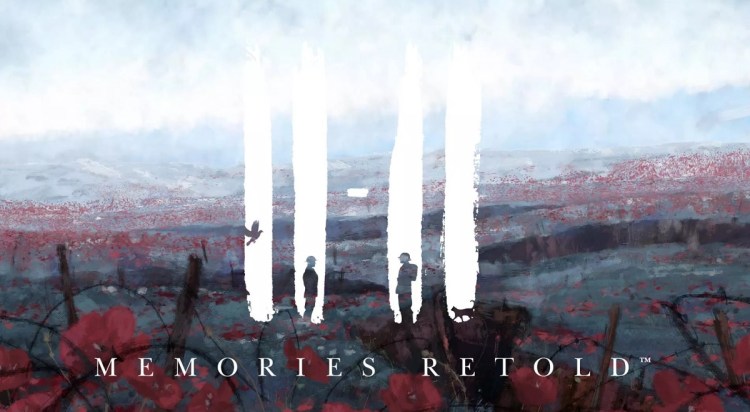11-11: Memories Retold is the latest game in the indie odyssey of Yoan Fanise, who left Ubisoft after 14 years to co-found the French game studio DigixArt Entertainment with his wife Anne-Laure Fanise. Their mission is to make “meaningful” video games.
Fanise previously created the music game Lost in Harmony, and while at Ubisoft he was co-creator of Valiant Hearts: The Great War, which won numerous awards for its tale of World War I. Now DigixArt is revisiting the war with a narrative-driven experience in partnership with collaborator Aardman Animation Studios and publisher Bandai Namco Entertainment.
I caught up with Fanise in an interview at the Electronic Entertainment Expo (E3), the big game trade show in Los Angeles last week. The game’s first teaser trailer showed beautiful watercolor art, with pictures of poppies amid the war-torn trenches of World War I. In the video, a British soldier recites In Flanders Fields, a moving poem by Canadian writer John McCrae, whose powerful words capture the view of the fields from the point of view of dead soldiers. It is one of my favorite poems.
And the second trailer shows more of the gameplay, where a British soldier and a German soldier meet, and they are accompanied by their pets, a pigeon and a cat. Rather than combat, the game will show the lives of the soldiers and their families, and how the animals can bridge their stories because they can cross enemy lines.
But while Valiant Hearts had a cartoon art style and told the tale of a soldier and his dog, 11-11: Memories Retold looks more serious in both its art style and storytelling. It will release on November 9 on the PS4, Xbox, and PC.
Here’s an edited transcript of our interview.

Above: Yoan Fanise is co-founder of DigixArt and developer of 11-11 Memories Retold.
GamesBeat: Are you showing anything here?
Yoan Fanise: No, but we’re releasing some footage. There are two trailers. One was last month, and one came last week. There’s more real game footage. The trailer starts to a bit of what the game is about, about those two characters, Harry and Kurt, and the animals, the pigeon and the cat. Both of them have companions.
The game is all about the meaning of war for humanity. I like to do stuff with meaning around it. This one is about peace. Even during war, those small moments of peace between people. World War I, there was no reason for this war to happen. People were there for no reason. We have a lot of moments where people choose not to fight. That’s interesting for me. That’s the focus we have, and on their relationships with their families. The game doesn’t only happen on the front. It happens behind the lines as well, at home with their families. When they come back, what do they think? Are they traumatized? What would they tell their kids?
Maybe it’s a naïve thing, but I’d like people to think about the word “enemy.” Enemies are nothing like—you’re either here or here. In the end, if we do well with the game, you’ll think, “What’s the point of this line?” It’s all about that. It’s pretty naïve, but it’s almost philosophical. That’s why we have those two animals, because they don’t care. They have no nationality. When you switch to the animal, you’re free to go to other side, free to fly. You realize that this is all so silly.
GamesBeat: What’s the starting point of the game?
Fanise: Harry is an American Canadian. His parents are American, but he moved to Toronto. He’s a photographer in a small shop. The army is looking for a photographer, so you as the player you decide to enlist and go to the front. He’s very young, very naïve. He’s voiced by Elijah Wood, so yesterday he was here and we talked a lot about the game. He loves the game. He’s really into the indie stuff, and he wanted to work on this project, so that was a big chance for us.
GamesBeat: When did he sign on compared to when you started?
Fanise: It took a while. We worked on the scenario for about a year. Then Bandai Namco asked me for a wish list of actors. I said, “Well, what kind of wish list?” They said, “Really, anybody.” So for me, when I thought about Harry, I thought about Wood – a young, naïve kind of guy. And then about a year later they said, “Yeah, we got him.” What the–? It was amazing, because it’s a small game, not a big triple-A game. I didn’t expect that to happen. The work on Bandai Namco’s part for this game is wonderful. It’s not for the sake of business. It’s just to make something.
GamesBeat: So the game starts during the war. Does it end beyond the end of the war?
Fanise: No, but—I can’t spoil much, but it ends on 11/11, 11 a.m. It’s very important that you have this kind of comedown when it stops. “Memories Retold” is more than a subtitle. It’s more like a brand name. Beyond the war, I’d like to talk about other things, other serious subjects under this banner of Memories Retold.
I think it opens up a lot of other things, this mechanic of switching from one side to the other. In many situations in our lives we might want to have more than one point of view. With a game it’s good because you can be both points of view. You can feel both ways. With the narration, you don’t just see what people say, but you hear what they’re thinking. This tool of narration on both sides is very important. The more you go through, the more you start to hear the other side, what happens on the other side. Then you switch and you’re looking at the other side. It’s a meaningful mechanic.

Above: 11-11: Memories Retold
GamesBeat: Valiant Hearts had more cartoonish graphics, a different art style. This is more realistic.
Fanise: Exactly. It’s weird, because while it’s more realistic as far as the size and shape of things, the emotions of it, it’s still a painting. I wanted to make a 3D painting. It’s a weird mix of both painting and realism. The emotion is amplified that way. Impressionist painting is something that makes you think about emotion. Van Gogh could make you feel with just a painting of a wall.
GamesBeat: Peace was a controversial thing during that war. The Russians withdrew, but they also brought about a revolution. The French stopped fighting, and were called mutineers.
Fanise: You know a lot about the subject. In this game, there were so many stories we could tell around World War I. We decided to stay on the western front. It’s mostly a story of families. We don’t focus much on the global picture. We don’t talk about Russia, for example. I want to keep this very human aspect. We still have a historical layer with the collectibles. If you want to know more, you can learn more that way. We had a historical panel with a German and a British historian. Everything in the game is made with an eye to both sides.
GamesBeat: Does it say something different from what you might have tried to say in the first game?
Fanise: It’s very different. In 11-11 you have a lot of choices. Valiant Hearts was a linear experience. This time we wanted to let people choose what they wanted to do. We have many endings that are very different. The emotions are very different. That’s what drives you. You might feel regrets. The question is, what would you do if you were at war? As Harry, for example, you’re a photographer. You’re supposed to take pictures. But what do you do if you see wounded men across the lines? Do you just take their picture? Do you help them? What do you do? I hope that people, even young people, can ask themselves some questions while playing this game – questioning the way of the world, basically.

Above: The trenches of World War I in 11-11: Memories Retold.
GamesBeat: We’re coming off a time where EA launched Battlefield One. There’s maybe a bit more awareness of the war. Does that help you at all?
Fanise: I think it can help bring more people to play the game, just through curiosity. I hope that they’ll discover that World War I, the mood and the feel of World War I, is very different from what it was in Battlefield. Battlefield One is very precise and accurate in terms of the visuals, but it’s only the look that’s accurate. After that, the mood, the ambiance, the way people talk to each other—it’s a shooter, and that’s okay. But for me, it misses the point of World War I.
That’s why I hope people will think about things like—if you know what it was like to be in the trenches, before the battle. Not during the battle. Actual combat, I think, was less than five percent of a soldier’s time. The rest was waiting, preparing, digging. We have a game within the game where you can play cards. It’s about friendship more than it’s about those moments of combat. There are very few of those in the game.

